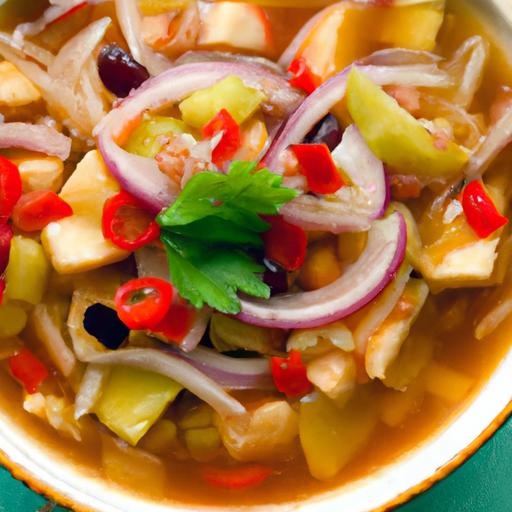In the vibrant tapestry of Salvadoran cuisine, few elements capture the heart of its culinary heritage quite like curtido. This tangy, crunchy fermented cabbage relish is more than just a side dish-it’s a zesty tradition that breathes life into pupusas, sandwiches, and countless family meals. Rooted in the kitchens of El Salvador for generations, curtido offers a perfect balance of acidity, spice, and freshness that awakens the palate and tells a story of cultural pride. Join us as we unravel the art of making authentic Salvadoran curtido, exploring the flavors, techniques, and secrets that transform humble ingredients into a lively, mouthwatering classic.
Tangy Traditions: How to Make Authentic Salvadoran Curtido
Tangy traditions shine brightly in the vibrant and refreshing Salvadoran curtido, a fermented cabbage relish that brings a crisp, zesty punch to any meal. Originating from the heart of El Salvador, curtido is a staple accompaniment for pupusas and other beloved dishes, reflecting both the country’s rich culinary heritage and its resourceful use of simple, fresh ingredients. My first taste was transformative-each bite was a perfect balance of tang, spice, and crunch that told the story of Salvadoran families gathering around the table with joy. Here, you’ll learn the secrets to crafting this authentic condiment, from selecting your ingredients to tailoring it perfectly to your palate.
Prep and Cook Time
- Preparation: 20 minutes
- Fermentation Time: 24 to 48 hours
- Total: Approximately 2 days including fermentation
Yield
About 4 cups (serves 6 as a side)
Difficulty Level
Easy to Medium
Ingredients
- 1 medium green cabbage, finely shredded (about 6 cups)
- 1 large carrot, julienned or grated
- 1 small white onion, thinly sliced
- 2 cloves garlic, minced
- 1-2 fresh jalapeños, thinly sliced (seeded for less heat)
- 1 tablespoon kosher salt
- 1 cup distilled white vinegar
- 1 cup water
- 1 teaspoon dried oregano (preferably Mexican oregano)
- 1 teaspoon sugar (optional for a slight balance)
Instructions
- Prepare the cabbage: Remove tough outer leaves of the cabbage, then finely shred it using a knife or mandoline. Place the cabbage in a large mixing bowl.
- Salt and massage: Sprinkle kosher salt over the shredded cabbage. Using clean hands, massage the cabbage thoroughly for about 5 minutes until it softens and releases its juices. This step kickstarts fermentation and provides a crisp texture.
- Add the vegetables: To the salted cabbage, add the julienned carrot, sliced onion, minced garlic, and jalapeño slices. Toss everything evenly.
- Prepare the brine: In a separate bowl, whisk together the distilled white vinegar, water, dried oregano, and sugar (if using), until the sugar dissolves completely.
- Combine and pack: Pour the vinegar mixture over the cabbage and vegetable blend. Stir gently and pack the curtido tightly into a clean glass jar or fermentation crock, pressing down firmly to remove any air pockets.
- Ferment: Cover the jar with a clean cloth or loosely secured lid to allow gases to escape. Leave it in a cool, dark place for 24 to 48 hours. Taste periodically; the flavors will develop a bright tang and the vegetables should maintain a crunchy texture.
- Refrigerate: Once fermented to your liking, seal the jar tightly and refrigerate. The curtido will continue to mellow and can be enjoyed over the next 2 weeks.
Tips for Customizing Curtido to Suit Your Taste Preferences
- Adjust the heat: Modify the number and type of peppers for subtle warmth or fiery kick. Habaneros or serranos add intensity, while removing seeds tames the heat.
- Play with spices: Try adding a bay leaf, fresh thyme, or a pinch of cumin to inject new aromatic layers.
- Vegetable swaps: Include thinly sliced radishes, bell peppers, or green beans for texture diversity.
- Sweetness balance: Add honey or agave instead of sugar for a natural sweet note that complements the acidity.
- Fast track fermentation: Use room temperature water and a pinch of live-culture starter (like whey or brine from previous curtido) to speed up tang development.
Chef’s Notes
For the best curtido, choosing crisp, fresh produce is essential; look for cabbage with tightly packed, vibrant leaves and carrots with firm texture. Over-fermenting can lead to a soggy texture, so tasting along the way is key. If you prefer a milder vinegar impact, reduce the vinegar amount and compensate with lemon juice for a brighter note. Curtido is a fantastic make-ahead condiment, often tasting better after a day in the fridge as flavors meld beautifully.
Serving Suggestions
Serving curtido cool with warm pupusas brings a delightful textural contrast and vibrant flavor. It also pairs excellently with grilled meats or fish, adding a refreshing zest. Garnish with freshly chopped cilantro or a squeeze of lime to amplify brightness, and offer extra pickled jalapeños for those who like it spicy. Try layering curtido in tacos or as a crunchy topping for avocado toast to elevate everyday dishes.

| Nutrient | Per Serving (¼ cup) |
|---|---|
| Calories | 25 |
| Protein | 1g |
| Carbohydrates | 5g |
| Fat | 0g |
Discover more traditional Salvadoran flavors like pupusas for a complete culinary journey. For in-depth fermentation tips, visit Cultures for Health.
Q&A
Q&A: Tangy Traditions – How to Make Authentic Salvadoran Curtido
Q1: What is Salvadoran Curtido, and why is it so special?
A1: Curtido is a vibrant, tangy Salvadoran cabbage slaw that acts as a zesty, crunchy companion to many traditional dishes-most famously pupusas. It’s special because it perfectly balances acidity, spice, and freshness, bringing brightness and a little kick that wakes up your taste buds with every bite.
Q2: What are the essential ingredients in authentic Salvadoran Curtido?
A2: Authentic curtido typically includes finely shredded cabbage, carrots, thinly sliced onions, and sometimes spicy chile flakes or fresh jalapeños. The magic happens when these veggies soak in a simple brine of vinegar, water, salt, and sometimes a touch of sugar, creating that signature tangy and slightly fermented flavor.
Q3: Can I make curtido without fermenting it for days?
A3: Absolutely! While traditional curtido hearts often prefer a slow ferment to develop depth, the quick-pickle method is equally beloved. Just mix your shredded veggies with vinegar, salt, and a pinch of sugar, then refrigerate for a few hours-voilà! You’ll have a refreshing curtido ready to enliven your meal in no time.
Q4: What dishes pair perfectly with curtido?
A4: Beyond the classic pupusas, curtido shines with grilled meats, tacos, burgers, and even as a crunchy topping for sandwich wraps. Its bright acidity cuts through rich, savory foods, adding balance and a burst of flavor that complements many cuisines.
Q5: How can I adjust the heat level if I’m sensitive to spice?
A5: Curtido’s spice comes from chile flakes or fresh peppers, but you can easily customize the heat. Use mild peppers like Anaheim or omit the chiles entirely and add a pinch of smoked paprika for subtle warmth. The key is to tailor the tangy goodness to your palate without losing the essence of the traditional recipe.
Q6: Is curtido healthy?
A6: Yes! Curtido is low in calories and packed with fiber and vitamins from the fresh veggies. Plus, if you ferment it naturally, you get the added benefit of probiotics, which support gut health. It’s a delicious way to add nutrition and zest to your meal.
Q7: What’s the secret to getting that perfect tangy and crunchy texture?
A7: The secret lies in shredding your veggies finely and letting them sit in the brine long enough to soften slightly without turning mushy. Using crisp, fresh cabbage and carrots and balancing the salt-to-vinegar ratio ensures each bite snaps and sings with tangy flavor.
Q8: Can I use different vinegars or add extra herbs?
A8: Traditional curtido sticks with white vinegar for its clean acidity, but experimenting with apple cider vinegar can add a fruity note. Feel free to toss in a bay leaf, oregano, or even fresh cilantro for a personalized twist while keeping the curtido’s signature punch intact.
Embrace this tangy tradition, and your kitchen will soon buzz with the savory, bright flavors of authentic Salvadoran curtido!
To Conclude
As the vibrant flavors of curtido linger on your palate, you’re not just tasting a tangy cabbage slaw-you’re savoring a piece of Salvadoran heritage steeped in tradition and communal spirit. Making authentic curtido is more than a recipe; it’s an invitation to explore the lively textures and zestful zing that define Salvadoran cuisine. Whether served alongside crispy pupusas or as a refreshing side to your favorite dishes, this humble fermented delight connects you to a culinary lineage rich with flavor and history. So next time you crave a burst of brightness on your plate, remember: a jar of curtido is more than a condiment-it’s a celebration of culture you can make at home. Embrace the tang, and let your kitchen tell a Salvadoran story.


